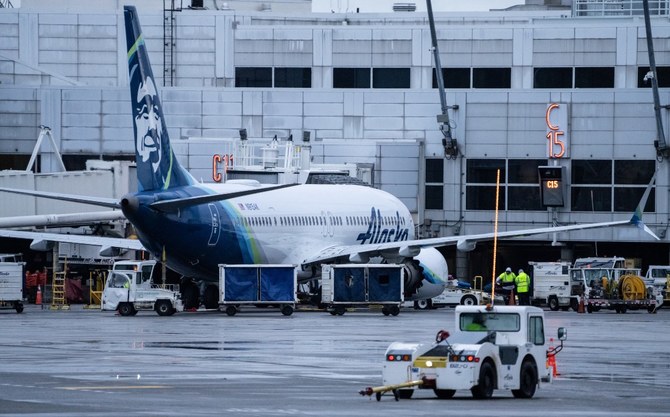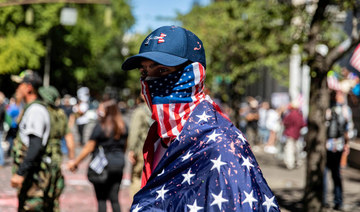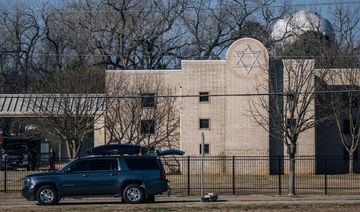PORTLAND, Oregon: The Boeing jetliner that suffered an inflight blowout over Oregon was not being used for flights to Hawaii after a warning light that could have indicated a pressurization problem lit up on three different flights, a federal official said Sunday.
Alaska Airlines decided to restrict the aircraft from long flights over water so the plane “could return very quickly to an airport” if the warning light reappeared, said Jennifer Homendy, chair of the National Transportation Safety Board.
Homendy cautioned that the pressurization light might be unrelated to Friday’s incident in which a plug covering an unused exit door blew off the Boeing 737 Max 9 as it cruised about three miles (4.8 kilometers) over Oregon.
The warning light came on during three previous flights: on Dec. 7, Jan. 3 and Jan. 4 — the day before the door plug broke off. Homendy said she didn’t have all the details regarding the Dec. 7 incident but specified the light came on during a flight on Jan. 3 and on Jan. 4 after the plane had landed.
The NTSB said the lost door plug was found Sunday near Portland, Oregon, by a school teacher — for now, known only as Bob — who discovered it in his backyard and sent two photos to the safety board. Investigators will examine the plug, which is 26 by 48 inches (66 by 121 centimeters) and weighs 63 pounds (28.5 kilograms), for signs of how it broke free.
Investigators will not have the benefit of hearing what was going on in the cockpit during the flight. The cockpit voice recorder — one of two so-called black boxes — recorded over the flight’s sounds after two hours, Homendy said.
At a news conference Sunday night, Homendy provided new details about the chaotic scene that unfolded on the plane. The explosive rush of air damaged several rows of seats and pulled insulation from the walls. The cockpit door flew open and banged into a lavatory door.
The force ripped the headset off the co-pilot and the captain lost part of her headset. A quick reference checklist kept within easy reach of the pilots flew out of the open cockpit, Homendy said.
The plane made it back to Portland, however, and none of the 171 passengers and six crew members was seriously injured.
Hours after the incident, the FAA ordered the grounding of 171 of the 218 Max 9s in operation, including all those used by Alaska Airlines and United Airlines, until they can be inspected. The airlines were still waiting Sunday for details about how to do the inspections.
Alaska Airlines, which has 65 Max 9s, and United, with 79, are the only US airlines to fly that particular model of Boeing’s workhorse 737. United said it was waiting for Boeing to issue a “multi-operator message,” which is a service bulletin used when multiple airlines need to perform similar work on a particular type of plane.
Boeing was working on the bulletin but had not yet submitted it to the FAA for review and approval, according to a person familiar with the situation. Producing a detailed, technical bulletin frequently takes a couple days, said the person, who spoke on condition of anonymity to describe a matter that the company and regulators have not publicly discussed.
Boeing declined to comment.
Without some of their planes, cancelations began to mount at the two carriers. Alaska Airlines said it canceled 170 flights — more than one-fifth of its schedule — by mid-afternoon on the West Coast because of the groundings, while United had scrapped about 180 flights while salvaging others by finding different planes.
Democratic US Sen. Maria Cantwell of Washington, chair of the Senate’s Commerce, Science and Transportation Committee, said she agreed with the decision to ground the Max 9s.
“Aviation production has to meet a gold standard, including quality control inspections and strong FAA oversight,” she said in a statement.
Before the discovery of the missing plug, the NTSB had pleaded with residents in an area west of Portland called Cedar Hills to be on the lookout for the object.
On Sunday, people scoured dense thickets wedged between busy roads and a light rail train station. Adam Pirkle said he rode 14 miles (22 kilometers) through the overgrowth on his bicycle.
“I’ve been looking at the flight track, I was looking at the winds,” he said. “I’ve been trying to focus on wooded areas.”
Before the school teacher named Bob found the missing door plug, searchers located two cell phones that appeared to have belonged to passengers on Friday’s terrifying flight. One was discovered in a yard, the other on the side of a road. Both were turned over to the NTSB, which vowed to return them to their owners.
Alaska Airlines flight 1282 took off from Portland at 5:07 p.m. Friday for a two-hour trip to Ontario, California. About six minutes later, the chunk of fuselage blew out as the plane was climbing at about 16,000 feet (4.8 kilometers).
One of the pilots declared an emergency and asked for clearance to descend to 10,000 feet (3 kilometers), where the air would be rich enough for passengers to breathe without oxygen masks.
Videos posted online by passengers showed a gaping hole where the paneled-over door had been. They applauded when the plane landed safely about 13 minutes after the blowout. Firefighters came down the aisle, asking passengers to remain in their seats as they treated the injured.
It was extremely lucky that the airplane had not yet reached cruising altitude, when passengers and flight attendants might be walking around the cabin, Homendy said.
The aircraft involved rolled off the assembly line and received its certification two months ago, according to online FAA records. It had been on 145 flights since entering commercial service Nov. 11, said FlightRadar24, another tracking service. The flight from Portland was the aircraft’s third of the day.
The Max is the newest version of Boeing’s venerable 737, a twin-engine, single-aisle plane frequently used on US domestic flights. The plane went into service in May 2017.
Two Max 8 jets crashed in 2018 and 2019, killing 346 people. All Max 8 and Max 9 planes were grounded worldwide for nearly two years until Boeing made changes to an automated flight control system implicated in the crashes.
The Max has been plagued by other issues, including manufacturing flaws, concern about overheating that led FAA to tell pilots to limit use of an anti-ice system, and a possible loose bolt in the rudder system.
Boeing jetliner that suffered inflight blowout was restricted because of concern over warning light
https://arab.news/ymb73
Boeing jetliner that suffered inflight blowout was restricted because of concern over warning light

Ex-cricketer and racism whistleblower Azeem Rafiq says Manchester Airport footage ‘triggering’

- The former cricket star said: “The man could have died and looking at his mother in the clip reminded me of my own”
- The family’s lawyer, Akhmed Yakoob, said that the man who was stomped on has a brain cyst and had undergone a CT scan following head injuries
LONDON: Former cricketer and racism whistleblower Azeem Rafik has said the footage of a Manchester Airport policeman stamping on an Asian man’s head was “incredibly triggering” and accused the police of “brutality.”
“I found the footage incredibly triggering; not just me, but the whole community and the rest of my family. It’s infuriating because that resonates, plus the way you get treated in airports generally, as a Muslim, since 9/11,” Rafiq told The Independent on Friday.
Video scenes surfaced on Tuesday showing a Greater Manchester Police officer kicking and stamping on the head of 19-year-old Mohammed Fahir, who was lying face down on the floor, with a woman believed to be his mother kneeling beside him.
Former cricket star, Rafiq, who is from Pakistan, said: “The man could have died and looking at his mother in the clip reminded me of my own.”
The ex-Yorkshire player spoke out in 2020 about the racism he suffered as a cricketer and his testimony to a select committee in 2021 led to a major overhaul in the county’s leadership.
“I have had dealings with the police around some of the death threats and attacks that were happening at my house and the lack of interest in protecting me and my family effectively, which is why I left the country.
“When that gentleman is on the floor defenseless, no context excuses that level of police brutality. Yet, you still have a lot of people defending that stuff, which is the scary bit,” said Rafiq, who now lives in Dubai.
The white officer was also shown in the video striking a second man, believed to be Fahir’s brother.
In a media brief at Rochdale police station on Thursday, the family’s lawyer Akhmed Yakoob revealed that the man who was stomped on has a brain cyst and had undergone a CT scan following his head injuries. Mohammed was “fighting for his life,” and Fahir’s brother and 56-year-old mother were also assaulted at the airport, according to Yakoob.
Rochdale’s Labour MP Paul Waugh has reportedly met the family and said that they have appealed for “calm in all the communities.”
Their elder brother, a serving officer with Greater Manchester Police, the lawyer said, was “too afraid” to go to work.
Rafiq told the publication that he was not optimistic that improvements would be made to policing following the incident and protests.
“We’ve seen these sorts of videos before, and it doesn’t seem to matter. The change doesn’t seem to get anywhere closer to change.”
Reform UK Deputy Leader Richard Tice came under fire for describing the alarming footage as “reassuring.”
Referring to the remarks as “sickening,” Rafiq said: “We’ve had members of parliament yesterday not only justifying it but actually advocating for that type of police response.
“As a person of color, and given the current dynamics around Muslims in this country, it’s a pretty scary place to be.”
Campaigners have expressed concern that the officer’s assault was racially motivated and steeped in Islamophobia, which has increased across England and Wales in recent months.
Rafiq called for support for the family, adding that the Independent Office for Police Conduct’s probe should happen “quickly and independently.”
Russian warships make routine visit to Cuba

- Russian residents were also among the few up early to see the fleet’s arrival
- The patrol ship Neustrahimiy, training vessel Smolniy and support vessels, all from the Baltic Fleet, are scheduled to depart on Tuesday
HAVANA: Havana residents watched from shore on Saturday as Russian warships arrived for the second time in as many months, in a visit that Cuba called routine.
Cuban authorities sent shots into the air to signal their welcome, while curious fishermen watched from Havana’s waterside promenade as the ships advanced up the bay. Russian residents were also among the few up early to see the fleet’s arrival.
The patrol ship Neustrahimiy, training vessel Smolniy and support vessels, all from the Baltic Fleet, are scheduled to depart on Tuesday.
A brief statement by the Cuban Revolutionary Armed Forces described their arrival as routine.
The US State Department and Pentagon did not immediately respond to a request for comment.
A Russian nuclear submarine, frigate and support ships in June also flexed Moscow’s muscles in the port of Havana, less than 100 miles (160 km) from Florida.
Tensions between the United States and Russia have increased since Russia’s 2022 invasion of Ukraine, and Russian naval activity — though routine in the Atlantic — has ratcheted up because of US support for Ukraine, US officials say.
Simultaneously, relations between Cold War allies Russia and Cuba have markedly improved as the Communist-run country battles an economic crisis it charges is due mainly to US sanctions.
High-level contacts between the two countries have increased to a level not seen since the fall of former benefactor the Soviet Union with Cuban President Miguel Diaz-Canel visiting Moscow four times.
Russia has sent oil, flour and increasing numbers of tourists to the cash and goods short Caribbean nation as citizens suffer through daily power outages and other travails resulting in scattered protests and record migration.
Ana Garces, a 78-year-old retiree, told Reuters she remembered the then-Soviet Union was the only country to help Cuba during the 1962 missile crisis, the peak of tensions with Washington when the world teetered on the brink of nuclear war.
“We are very grateful,” she said. “Why should we not receive it with open arms? This is friendship. All kinds of ships have entered here.”
“It shows how other countries do support us and takes away a little of the world’s mentality about our country,” added her husband, 71-year-old retiree Rolando Perez.
Bangladeshi police arrest student protest leaders from hospital

- Police say they arrested three student leaders ‘to keep them safe’
- Two of them were still undergoing treatment, hospital worker says
DHAKA: Bangladeshi police have discharged from hospital and arrested the leaders of a student protest that led to nationwide unrest last week, when security forces clashed with demonstrators.
Students have been demonstrating since the beginning of July against a rule that reserves a bulk of government jobs for the descendants of those who fought in the country’s 1971 liberation war.
At least 209 people have been killed and thousands injured, according to a count based on reports in the local media after the protests turned violent last week.
Most of the casualties were reported in Dhaka, which saw intense clashes between protesters, government supporters, police and paramilitary troops, when the country went into a communications blackout for six days.
Among the injured were student leaders Nahid Islam and Asif Mahmud, coordinators of Students Against Discrimination, the main protest organizing group. They were patients at Gonoshasthya Hospital in Dhaka, from where they were arrested by the Detective Branch of Dhaka Metropolitan Police on Friday evening. Another student leader visiting Islam and Mahmud, Abu Baker Majumder, was detained as well.
Detective Branch chief Harun Or-Rashid told reporters in Dhaka on Saturday that the trio had been detained “for security reasons” as their families were worried about their safety.
“We took them in our custody to keep them safe,” he said.
The student leaders were arrested by a group of more than a dozen plainclothes officers despite objections from medical staff, a hospital worker told Arab News.
“At first, we tried to make them understand that without proper protocols, admitted patients couldn’t be released from the hospital. Later on, they talked with our authorities, and the students were taken from the hospital. There was no way we could hold them further,” the hospital worker said on condition of anonymity.
“The students’ health was not so good ... Asif was dealing with low blood pressure, and Nahid was suffering from blood clots and bruises on different parts of his body. Both of them needed further treatment.”
The arrests come in a crackdown launched by police in Dhaka, where a curfew imposed last week was still in place.
Liton Kumar Saha, joint commissioner of the Dhaka Metropolitan Police, said that 2,284 people have been arrested in Dhaka over the protest-related clashes, in which numerous administration offices were set on fire.
“We are analyzing the footage of different places and identifying the miscreants. When we get confirmed about someone’s involvement in the anarchy, we conduct the operations to arrest them. It has been conducted with transparency, and we are checking the people who were involved with sabotage,” he told Arab News.
“In the last 24 hours, 245 persons were arrested in Dhaka. Our drive will continue until the situation gets normal.”
International rights groups have repeatedly raised concerns over Bangladesh’s handling of the protests, with Amnesty International saying that witness testimonies and video and photographic evidence “confirm the use of unlawful force by the police against student protesters.”
The protests broke out after the High Court upheld a controversial quota system, in which 56 percent of public service jobs were reserved for specific groups, including women, marginalized communities and children and grandchildren of freedom fighters — for whom the government earmarks 30 percent of the posts.
The Supreme Court last week scaled back the quota system, ordering 93 percent of government jobs to be allocated on merit.
Russia slams Olympic opening as ‘massive failure’

- “I wasn’t planning to watch the opening. But after seeing the photos, I couldn’t believe it wasn’t a deep fake or photoshop,” Zakharova wrote on Telegram
- “Ridiculous open-air opening ceremony forced guests to sit for hours under pouring rain“
MOSCOW: Russia on Saturday slammed the opening ceremony of the Paris Olympic Games as a “massive failure.”
Foreign ministry spokeswoman Maria Zakharova gave a long list of shortcomings at Friday’s ceremony, which was not broadcast live on Russian television.
“I wasn’t planning to watch the opening. But after seeing the photos, I couldn’t believe it wasn’t a deep fake or photoshop,” the spokeswoman wrote on Telegram
Only a few Russian athletes have been approved to participate in the Games as “neutrals.” Competiors under the Russian flag have been banned over Russia’s military offensive in Ukraine.
Zakharova wrote that the “ridiculous open-air opening ceremony forced guests to sit for hours under pouring rain.”
“The organizers did not think of either seeding the clouds or awnings,” she said, referring to Russia’s practice of sending up planes ahead of major outdoor events to attempt to break up clouds.
France detained a Russian man just ahead of the Games’ opening, accusing him of a “destablization” plot for the event. “I wonder how many more ‘spies’ had to be embedded for the opening of the Olympics in Paris to end up such a massive failure?” said Zakharova.
Zakharova also mocked the “transport collapse” on the day, after three arson attacks on the rail system, and France’s blaming this on sabotage.
She said the center of Paris was “transformed into a ghetto for homeless people,” while “rats flooded the streets.”
Other targets were the US rapper Snoop Dogg carrying the Olympic torch and gaffes such as introducing the South Korean team as North Korea and raising the Olympic flag upside-down.
Zakharova picked on a part of the opening ceremony featuring drag queens, interpreted by some as parodying The Last Supper. She called it a “mockery of a sacred story for Christians,” saying that “the Apostles were shown as transvestites.”
“Evidently in Paris they decided that if the Olympic rings are multi-colored, you can turn it all into one giant gay parade,” she added.
A spokesman for the Russian Orthodox Church, Vakhtang Kipshidze, also condemned this section, writing on his personal Telegram channel that it was “cultural and historical suicide.”
Indian PM Modi likely to visit Ukraine in August, local media reports

- Ukraine’s embassy in New Delhi said it had no information to share immediately
- There was no immediate response from India’s foreign ministry
NEW DELHI: Indian Prime Minister Narendra Modi is likely to visit Ukraine next month, a local media report said, his first visit to the country since its war with Russia began and just weeks after he met Russian President Vladimir Putin in Moscow.
Ukraine’s embassy in New Delhi said it had no information to share immediately. There was no immediate response from India’s foreign ministry.
Western countries have imposed sanctions on Moscow following its all-out invasion of Ukraine in 2022, but “friendly” nations such as India and China have continued to trade.
India has refrained from directly blaming Russia, while urging the two nations to resolve their conflict through dialogue and diplomacy.
Modi met Putin just as a Russian missile struck a hospital in Kyiv killing at least 41 people. The Indian leader told Putin that the death of innocent children was “painful and terrifying.”
Ukraine’s President Volodymyr Zelensky expressed unhappiness over Modi’s visit, calling it a “huge disappointment and a devastating blow to peace efforts” to see him hug “the world’s most bloody criminal in Moscow on such a day.”
Russia denied striking the hospital.
The US State Department has raised concerns over India’s relationship with Russia especially at a time when it has been seeking to strengthen ties with India as a potential counterweight to an ascendant China.
New Delhi is seeking to deepen its relationship with the West while keeping ties intact with Russia.
The final date of Modi’s visit is not yet confirmed, The Print reported on Saturday.






















